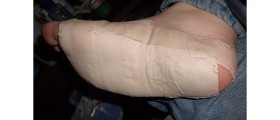I am 30 years old and I have been suffering for 10 years now. I’ve seen over 40+ different gynecologists with the same negative results and hearing that it’s “normal discharge” again and again. I’ve been prescribed every antibiotics in the books with no relief. Everyday I have HEAVY clumpy sticky yellow discharge ( I need to wipe every few hours or change my underwear), itching around the opening, really bad abdominal pain, pelvic pain, painful urination, pelvic pain while when having a bowl movement, and painful intercourse (which I barely have due to do the discharge embarrassment). The discharge has a very faint metallic/sour smell and I feel like it’s the only difference I see between bv which apparently has a fishy odor and my symptoms. The discharge is a little bit clearer when I’m ovulating but still has a tint of yellow. Only day I get relief is a day or two before and after my period.
I’m really confused as to why my tests comes back normal/negative. I’ve tried everything I see on the internet, boric acid, coconut oil, tea tree, douches, peroxide and nothing has worked. I barely have any sugar intake and I don’t smoke. I’m really depressed and I don’t know what to do.
I’ve never been checked for cytolytic vaginosis but can this be the culprit? I’ve tried baking soda douches for two days and I feel like it made it worse. I’m trying baking soda suppositories now but I’m getting a lot of watery discharge with a slight tint of yellow and I just don’t feel good over all as I feel like it’s causing more abdominal/pelvic pain. Is this normal? How long should I do this if I don’t see results? Or is this something else and not cv?
Loading...
I'm truly sorry to hear about your prolonged discomfort and the distress it has caused you. It sounds like you've been through a lot and seen many healthcare providers, which can be incredibly frustrating when you're not getting answers or relief.
Cytolytic vaginosis (CV) is a less common vaginal condition that can mimic some symptoms of both yeast infections and bacterial vaginosis. It's characterized by an overgrowth of lactobacilli, which are usually the "good" bacteria in the vagina. Overgrowth of lactobacilli leads to increased breakdown of cells in the vaginal lining and can cause symptoms like itching, burning, and abnormal discharge. The typical discharge of CV is often described as thick and white, similar to a yeast infection, but without the yeast smell. Instead, it might have a slightly sour or metallic smell due to the excess lactic acid produced by the lactobacilli.
Diagnosing CV typically involves microscopic examination of vaginal discharge to identify the lactobacilli and the breakdown of vaginal cells. The treatment for CV is different from treatments for yeast infections or bacterial vaginosis. The goal is to reduce the number of lactobacilli in the vagina. This might involve using baking soda douches or sitz baths, but it's essential to get a clear diagnosis before attempting to treat it yourself, especially given your history and the potential for misdiagnosis.
Regarding your experience with baking soda douches and suppositories, it's crucial to consult with a healthcare professional about any adverse reactions or symptoms you're experiencing. It might not be the right treatment for you, or there might be another underlying condition at play.
Given the complexity and chronic nature of your symptoms, it might be beneficial to explore a few avenues:
-
Seek a Specialist: Consider seeing a vulvovaginal specialist or a vulvovaginal clinic if there's one near you. These clinics specialize in chronic vaginal and vulvar issues.
-
Pelvic Physical Therapy: Some of your symptoms, like painful urination, painful bowel movements, and painful intercourse, can sometimes be linked to pelvic floor dysfunction. A pelvic physical therapist might be able to provide an evaluation and therapy if this is the case.
-
Holistic or Integrative Medicine: Some people find relief with holistic or integrative medicine approaches, which might involve a combination of traditional and alternative treatments.
Loading...
















